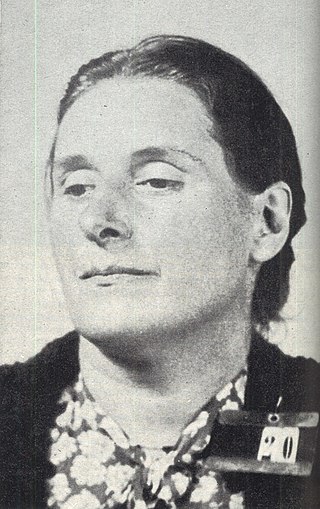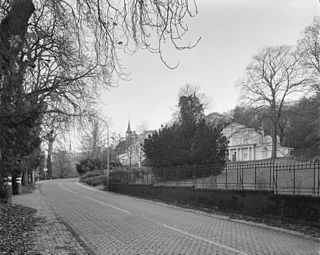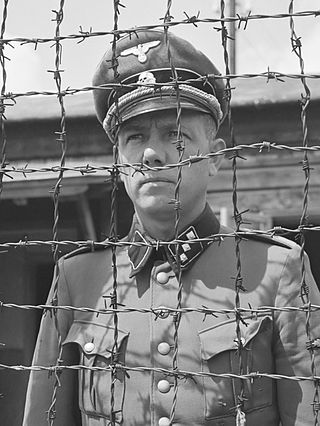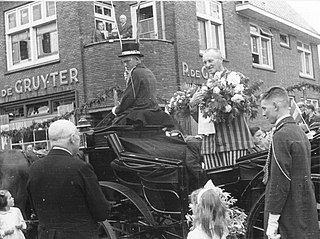
Camp Westerbork, also known as Westerbork transit camp, was a Nazi transit camp in the province of Drenthe in the Northeastern Netherlands, during World War II. It was located in the municipality of Westerbork, current-day Midden-Drenthe. Camp Westerbork was used as a staging location for sending Jews, Sinti and Roma to concentration camps elsewhere.

Vught is a municipality and a town in the Province of North Brabant in the southern Netherlands, and lies just south of the industrial and administrative centre of 's-Hertogenbosch. Many commuters live there, and in 2004 the town was named "Best place to live" by the Dutch magazine Elsevier.

Kamp Amersfoort was a Nazi concentration camp near the city of Amersfoort, the Netherlands. The official name was "Polizeiliches Durchgangslager Amersfoort", P.D.A. or Amersfoort Police Transit Camp. 37,000 prisoners were held there between 1941 and 1945. The camp was situated in the northern part of the municipality of Leusden, on the municipal boundary between Leusden and Amersfoort in the central Netherlands.

Herzogenbusch was a Nazi concentration camp located in Vught near the city of 's-Hertogenbosch, Netherlands. The camp was opened in 1943 and held 31,000 prisoners. 749 prisoners died in the camp, and the others were transferred to other camps shortly before Herzogenbusch was liberated by the Allied Forces in 1944. After the war, the camp was used as a prison for Germans and for Dutch collaborators. Today there is a visitors' center which includes exhibitions and a memorial remembering the camp and its victims.

Johann Baptist Albin Rauter was a high-ranking Austrian-born SS functionary and war criminal during the Nazi era. He was the highest SS and Police Leader in the occupied Netherlands and therefore the leading security and police officer there during the period of 1940–1945. Rauter reported directly to the Nazi SS chief, Heinrich Himmler, and also to the Nazi governor of the Netherlands, Arthur Seyss-Inquart. After World War II, he was convicted in the Netherlands of crimes against humanity and executed by firing squad.

Schoorl transit camp, originally a Dutch army camp (1939–1940), was a Nazi concentration camp (1940–1941) near the village of Schoorl in the Netherlands.

Adrienne Minette (Mies) Boissevain-van Lennep was a Dutch feminist who was active in the Resistance before being arrested by the Nazis and sent to the Herzogenbusch concentration camp. After the war, she promoted the idea of the national liberation skirt, and some of these unusual skirts are now in Dutch museums.

Nieuw Vosseveld is a prison in Vught, Netherlands, part of the Custodial Institutions Agency of the Ministry of Justice and Security within the Dutch criminal justice system. Penitentiaire Inrichting Vught is now the general term used instead of Nieuw Vosseveld. Part of Nieuw Vosseveld is a maximum security prison; it holds some of Europe's most dangerous criminals, including Mohammed Bouyeri and Ridouan Taghi.

Rijksstraatweg or simply Straatweg was the term for paved roads of interregional significance in the Netherlands in the 19th and early 20th centuries. These roads were built by the national government, and formed the country's first centrally planned highway network. They received route numbers, eventually resulting in a nationwide network of 82 highways. It formed the basis for today's system of nationally controlled roads, the Netherlands' main highway grid.

Subcamps, officially Arbeitslager der Waffen-SS, were outlying detention centres (Haftstätten) that came under the command of a main concentration camp run by the SS in Nazi Germany and German-occupied Europe. The Nazis distinguished between the main camps and the subcamps subordinated to them. Survival conditions in the subcamps were, in many cases, poorer for the prisoners than those in the main camps.
The following is a timeline of the history of the municipality of Eindhoven, Netherlands.

Karl Friedrich Titho was a Germany military officer, who as commander of the Fossoli di Carpi and Bolzano Transit Camps oversaw the Cibeno Massacre in 1944. Titho was jailed in the Netherlands after World War II for other war crimes committed there, released in 1953, and then deported to Germany. Despite an arrest warrant in Italy in 1954, Titho was never extradited to stand trial for his actions in Italy, and died in Germany in 2001, confessing and repenting his role in the atrocities just days before his death.

During World War II, the German Luftwaffe staffed dozens of concentration camps, and posted its soldiers as guards at many others. Camps created for the exploitation of forced labor for armaments production were often run by the branch of the Wehrmacht that used the products. The Wehrmacht also posted about 10,000 soldiers to concentration camps because of a shortage of guards in mid-1944, including many from the Luftwaffe.

Der Ort des Terrors. Geschichte der nationalsozialistischen Konzentrationslager is a nine-volume German encyclopedia series of Nazi Germany's camp system, published between 2005 and 2009 by Wolfgang Benz and Barbara Distel for C. H. Beck. It was edited by Angelika Königseder of the Zentrum für Antisemitismusforschung. The first volume deals with central issues concerning the Nazi camp system, volumes 2 to 7 contain articles on the main concentration camps and their subcamps in chronological order. Volume 8 deals with concentration and extermination camps in German-occupied Eastern Europe. Volume 9 also lists other types of camps in the Nazi forced labor camp system.

Karl Peter Berg was a German camp commander, who was sentenced to death after World War II for war crimes committed during the German occupation of the Netherlands.

Walter Heinrich was a German SS-Obersturmführer. As such, from August 1941 to 1 March 1943, he was in charge of Kamp Amersfoort concentration camp as Lagerkommandant.

Antonius (Anton) Johannes Schaars was a Dutch Roman Catholic priest who helped rescue members of the Allied forces during World War II.















